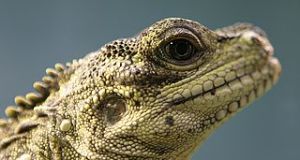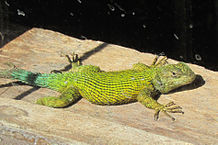Released and escaped green iguanas (Iguana iguana) have now established huge populations in southern Florida. Although I must admit to a certain degree of fascination with introduced species, there can be no doubt that the massive lizards have caused a great many problems in their adopted environment.
An Impressive but Bothersome Invader
Normally arboreal, iguanas adapt to treeless environments by commandeering burrows occupied by the endangered burrowing owl (Athene cunicularia), displacing the birds and destroying eggs and chicks in the process. Ever hungry, the 4-6 foot long behemoths also assist the spread of undesirable invasive plants by eating their fruits and dispersing the seeds in their feces.
Among one of their most troublesome characteristics is a propensity to colonize airway strips and nearby areas. Green iguanas in Puerto Rico have caused runway accidents, and they are considered a collision hazard in Florida airports as well.
Raccoons in Cities and Nature Preserves
 Raccoons, although native, have also become problematical in recent years. Now well adjusted to people, they thrive everywhere…during my years as a nuisance wildlife trapper, I caught scores throughout NYC, including in some of Manhattan’s most densely-populated neighborhoods.
Raccoons, although native, have also become problematical in recent years. Now well adjusted to people, they thrive everywhere…during my years as a nuisance wildlife trapper, I caught scores throughout NYC, including in some of Manhattan’s most densely-populated neighborhoods.
Raccoon populations in south Florida parklands reach 250 animals per square kilometer – 200 times the densities of those dwelling in natural habitats! In addition to serving as a reservoir for rabies and distemper, raccoons in Florida pose a serious threat to the nesting success of green, loggerhead and other marine turtles.
Please check in next week to see how a well-planned control program for both iguanas and raccoons went astray…and would up helping the iguana population to grow astronomically!
Further Reading
Iguanas make fascinating pets, but, as males may exceed 6 feet in length, they are not for the unprepared. Please read our cage guide, Green Iguanas, before you take on one of these impressive giants. Green Iguana image referenced from Morguefile.
 That Reptile Blog – Reptile, Amphibian and Exotic Pet Care and Information
That Reptile Blog – Reptile, Amphibian and Exotic Pet Care and Information




Hi All
I have an anole, Ivy. I would like to get some info about lighting. I know that if I use one kind of light it will blind her, how much real sunlight should she have? Is there a lite set that has a place for both type of (day and night), so I can just flip a switch. I’m going through to many bulbs. I never knew I would love a lizard, but I do and I want to give her the best, so she can have a healthy life.
Thanks for you time
Beth
Hello Beth, Frank Indiviglio here.
Thanks for your interest in our blog. It’s easy to become confused concerning lighting, as there is a great deal of misleading and overlapping information on the inter net these days. Thanks for taking the time to ask.
The most important type of light for your anole is UVB, which allows it to produce Vitamin D3 in the skin and, consequently, to utilize the calcium in its diet. Amphibians may suffer eye damage from overexposure, but not anoles under normal circumstances. The Zoo Med 10.0 bulb is the best florescent UVB source, but others are suitable also… if you have another, please write in and I’ll send further details. The lizard should be able to bask within 6-12 inches of the bulb.
An incandescent bulb will be needed to provide a warm basking site (florescent bulbs do not emit enough heat). The Reptile White bulb is a good choice, as it provides heat and UVA light. UVA is important in promoting normal activity and reproduction, but is not critical to survival. This bulb should be near the UVB bulb, to assure adequate UVB exposure (the heat will attract the lizard).
A night light would only be necessary if temperatures go below 70F.
As for your question regarding sunlight, exposure is ideal but please bear in mind that glass and plastic will filter out the UVB rays, so an outdoor screen cage is needed. Using one will go a long way in assuring your lizard’s health, but remember that anoles placed outdoors for basking must have access to shade as well, and of course must be protected from cats and other predators.
I’m unclear as to how often you are replacing bulbs…please write back with some details and the make/model of the bulbs and I’ll be happy to help. Most UVB bulbs have an active life of 6-12 months.
I’m assuming you have a green anole, but the guidelines above apply to most other species as well. Diet, humidity and other factors are also critical elements of anole husbandry…they are quite delicate in some regards. Please see my article on the Natural History and Care of Green Anoles for further details, and be sure to write back if you have any questions.
Good luck and enjoy,
Best regards, Frank Indiviglio.
I have a Green Iguana on my roof and in my yard. How do I get rid of it?
Hello, Frank Indiviglio here.
Thanks for your interest in our blog. Unfortunately it’s difficult to discourage iguanas in Florida, and new ones often move in once a resident animal is removed. This University of Florida article covers all the options, including removal by professional trappers, and the applicable laws (i.e. iguanas cannot be released elsewhere).
Please let me know if you need any further information. Good luck and please keep me posted.
Best regards, Frank Indiviglio.
When i lived in japan for 4 years there was alot of iguanas, i rember big green ones but i allso rember medium drifrent colerd iguana’s and lizards that would all live in this one gaint tree with spiked and low hanging branches. They wernt to fear full and they were easy to watch up there. Same tree had cacadea husks all over it.
I didn’t realize green iguanas (Iguana iguana) were introduced there..thanks!